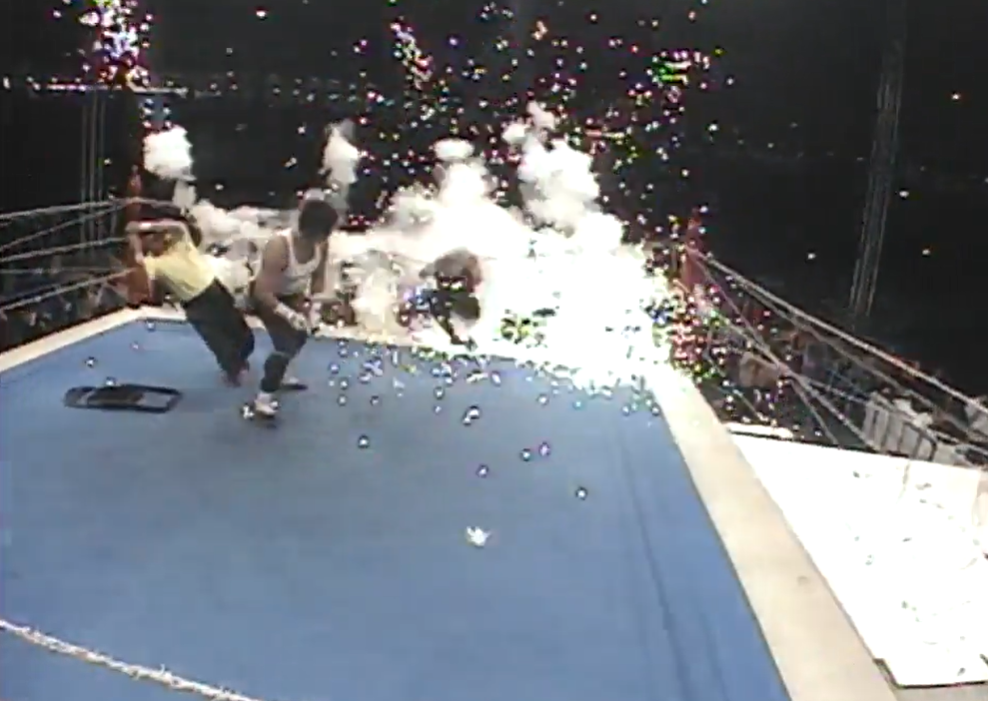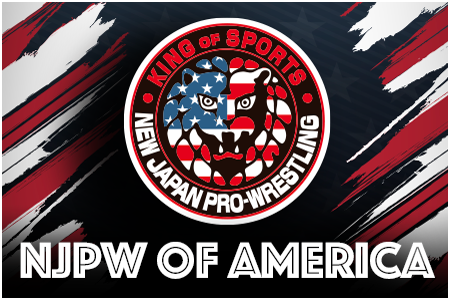It’s time for another dip into the ever expanding NJPW World archives. Sadly, the annual spring big event of Sakura Genesis was taken off the schedules this year, but there are plenty of past spring events to look at here this week.
April 4, 1994: Hiroshima Generations

All the fours seemed to line up in Hiroshima some 26 years ago. It was April 4, 1994, and Shinya Hashimoto, already having cleared four defences in his first IWGP Heavyweight Championship reign, was now facing the 40 year old Tatsumi Fujinami. It was however the very first singles match between the two, and over the richest prize in professional wrestling.
For the 28 year old Hashimoto, his first title win represented a sea change in NJPW; indeed, taking the title over another young star in the Great Muta at the end of 1993 indicated that a new generation of wrestlers had finally hit the very top flight. Fujinami, however was the old guard that would not be put to pasture just yet.
For Fujinami, the chance to push through the pain of an injured back to claim his fifth IWGP Heavyweight Championship, and his first in two years. As Hashimoto sought to lead the younger generation of NJPW prospects, he would state that Fujinami was ‘the very last person I would want to take the belt off of me’. He certainly brought unbelievable aggression to suit. Whose fighting spirit would burn stronger?
April 5, 2009: CHAOS is Born

Togi Makabe walked into Resolution 2009 in Ryogoku Sumo Hall facing a man in Shinsuke Nakamura that couldn’t seem more different on the surface, but who shared a similar past in many ways. Makabe and Nakamura were certainly very different stylistically, but both had a difficult journey and had no re-emerged truly at home with who they were.
For Nakamura, an IWGP Champion a mere 15 months into his career, some very difficult lessons had to be learned at the very top flight, and it was only now, some seven years removed from his debut, that fans were seeing the King of Strong Style that truly captivated people around the globe. Makabe, meanwhile had spent over a decade toiling in the ring and not quite tapping into what made him a star until he embraced his inner thug, joining and then seizing control of Great Bash Heel.
GBH was the most violent of forces that could not and would not be trusted. A 4-2 record between Nakamura and Makabe respectively had last seen Nakamura put Makabe out of the New Japan Cup in the first round; Makabe demanded a rematch; something Shinsuke accepted, only vowing that he would do what it took to end Makabe once and for all.
As it happened, that included shockingly joining forces with Toru Yano. This would be the first blow to GBH that would result in all but Tomoaki Honma leaving Makabe and the group to form a new unit known as CHAOS.
April 6 2019: Rain in New York

Traditionally the biggest event of the spring in New Japan Pro-Wrestling takes place in Ryogoku, but in 2019, things got even bigger. When NJPW and ROH announced that they would combine forces for G1 Supercard, anticipation was at a fever pitch from the get go, and when tickets went on sale, 16,000 plus snapped them up in mere minutes.
What that meant, contrary to his own beliefs, was that Jay White did not ‘single handedly sell out Madison Square Garden’, but he did stand deservedly in its main event. At New Beginning in Osaka, White unseated Hiroshi Tanahashi to become IWGP Heavyweight Champion on his first attempt. Jay’s dominant 2018 had turned into new highs at the turn of the year.
Yet the grandest stage at MSG would require the greatest prize to be at stake. The biggest ever New Japan Cup that March would grant its winner Okada the challenger position in The World’s Most famous Arena. Okada had come off five demanding singles matches in one month to stand opposite the Switchblade, who had a month to prepare, and was in seemingly unbeatable form; it seemed as if the odds were in favour of the champion heading into the biggest international main event in NJPW history.
April 7, 2013: Bad Luck, Taguchi

There’s just something about Ryogoku in the spring time. Four years after Toru Yano turned his back on Togi Makabe and started the ball rolling toward an era of CHAOS, Prince Devitt would call an end to his long relationship with Ryusuke Taguchi, and the chain of events that birthed BULLET CLUB began.
Apollo 55 had dominated the IWGP Junior Heavyweight Tag Team scene through the early part of the decade, with four championship reigns between 2010 and 2012. At the turn of 2013 however, Devitt had taken on a new and more aggressive demeanour, something that became especially clear when he took on Hiroshi Tanahashi at the Anniversary Event in March. Devitt was determined to break through what he perceived as the glass ceiling that existed for him as a junior heavyweight and wanted to use every means necessary to do so. Taguchi wanted to fight with more honesty, and the two would butt heads right up to Apollo 55 challenging Alex Shelley and KUSHIDA, the Timesplitters in Ryogoku.
After Taguchi lost the match for his team, Devitt would violently assault his partner. Confronted by Shelley and KUSHIDA, Devitt would call on backup in the form of the man once known as King Fale, now back from excursion and officially appointed as Devitt’s ‘bouncer’: Bad Luck Fale. Now walking away from the main NJPW crew, the two stood apart from everybody on an island unto their own; for now.
April 10, 1999: Big Egg, Big Bang

The Tokyo Dome has been home to plenty of violent encounters over the years. As recently as this January 4, Jon Moxley and Lance Archer went to war in a Texas Deathmatch. In 1999 however, the most explosive of violent bouts took place underneath the shell of the Big Egg.
Atsushi Onita walked to the beat of his own drum through his entire career. Having had an orthodox start as a junior heavyweight in All Japan Pro Wrestling, he became an innovator of the hardcore deathmatch style in the FMW promotion. He would walk away from FMW in the late 1990s however, and almost from professional wrestling entirely, before he hit NJPW rings in 1999.
Onita positioned himself as the ultimate anti-establishment figure against the established success of the cerulean blue. In his mind, nobody embodied the professional wrestling establishment more than the retired Riki Choshu, and he began a campaign to bring Choshu out of retirement by taking on his student Kensuke Sasaki at the start of the year.
At April’s Strong Style Symphony, though, he would butt heads with another anti-establishment figure in Masahiro Chono. As the leader of nWo Japan, and in the early stages of building the team known as Team2000 around himself, Chono was used to going against the authoritarian grain, but he felt strongly that Onita’s brand of wrestling had no place in NJPW. The two would eventually head into Onita’s form of match, an electrified barbed wire rope explosion deathmatch.
It was a match that was almost entirely kept off the record. Not on the main card, it was instead billed as a special opening bout. It’s main referee was not NJPW’s Tiger Hattori but a referee then primarily officiating in the WAR company by the now familiar name of Red Shoes Unno. It was by no means a normal match for by no means a normal night in the Tokyo Dome.





